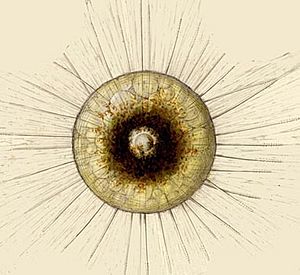Bikont facts for kids
A bikont (say "BY-kont") is a type of tiny living thing called a eukaryote. Eukaryotes are organisms whose cells have a special control center called a nucleus. Many bikonts are single-celled, meaning they are made of just one cell. The name "bikont" means "two flagella." A flagellum (say "fla-JELL-um") is like a tiny whip or tail that helps these organisms move around. Scientists believe the very first bikonts also had two flagella.
Quick facts for kids Bikonts |
|
|---|---|
 |
|
| A radiolarian | |
| Scientific classification |
|
| Domain: | Eukaryota |
| (unranked): | Bikonta Cavalier-Smith, 1993 |
| Subgroups | |
|
Apusozoa |
|
| Synonyms | |
|
|
What Makes Bikonts Special?
Besides often having two flagella, bikonts share another interesting feature inside their cells. This feature involves their genes and the special jobs they do.
How Their Genes Work
Inside every living thing, genes carry instructions for building proteins. Proteins do most of the work in cells, like helping with chemical reactions. Proteins that speed up these reactions are called enzymes.
In bikonts, two specific genes have joined together. These genes are called thymidylate synthase (TS) and dihydrofolate reductase (DHFR). Instead of making two separate proteins, these two genes now work as one unit. They create a single protein that can do both jobs!
Think of it like two different tools that have been combined into one super-tool. This single protein can perform two important functions that are usually done by two separate proteins.
Bikonts vs. Unikonts
Scientists also study another group of eukaryotes called unikonts. The word "unikont" means "one flagellum." Unikonts include animals, fungi, and some other tiny organisms.
In unikonts, the TS and DHFR genes are still separate. They make two different proteins that work independently. This difference in how their genes are organized helps scientists understand how different groups of living things are related.
See also
 In Spanish: Bikonta para niños
In Spanish: Bikonta para niños

